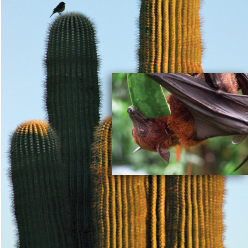 Darwinists teach that nature is just a gladiatorial arena of cutthroat competition and selfish struggle—a conquer-or-be-conquered “survival of the fittest” contest. They routinely skew their caricature of nature to overemphasize its brutal death struggle as if death were some sort of good, driving life force.
Darwinists teach that nature is just a gladiatorial arena of cutthroat competition and selfish struggle—a conquer-or-be-conquered “survival of the fittest” contest. They routinely skew their caricature of nature to overemphasize its brutal death struggle as if death were some sort of good, driving life force.
But how should a Christian view nature? Scripture teaches that creation is seriously fallen.1 However, creation retains much of its created goodness and harmony, even while “groaning” with entropy and mortality. If we look carefully, the original neighborliness of nature is still easy to see.
Creation retains much of its created goodness and harmony, even while “groaning” with entropy and mortality. ![]()
Saguaro Cactus, Receiving and Giving
Saguaro cacti provide food, perching sites, and shelter cavities for desert birds such as the Gila woodpecker, elf owl, Chihuahuan raven, Inca dove, cactus wren, and many others. Likewise, saguaro fruit is eaten by hungry peccary, deer, tortoises, rabbits, rodents, and skunks. Fallen saguaro branches constitute shelter for scorpions, tarantulas, insects, lizards, and snakes.2
Yet saguaro cacti, helpful and generous as they are to their neighbors, also receive vital benefits from them, illustrating the symbiotic dynamics of America’s southwestern deserts.
Without other species, Saguaros themselves could not persist. The giant cactus is dependent upon pollinators, now mostly bees [or white-winged doves] but traditionally bats. Saguaros also need “nurse trees” such as paloverdes to provide shade during the early years of slow growth…. [Also,] a Saguaro whose stem is injured is subject to rapid and fatal necrosis from bacterial invasion. However, the site of the injury is an ideal place for a Gila Woodpecker to begin excavating a nest cavity. In doing so, the woodpecker may remove all of the diseased tissue, essentially curing the cactus of what might have been a fatal infection.2
When bat populations were higher, they were the primary pollinators of saguaro and other desert cacti such as the cardon and organ pipe.2,3
Tropical Bats, Receiving and Giving
Bats provide pollinating services in deserts and elsewhere while acquiring nectar from cactus flower blossoms. Insectivorous bats consume crop-pest bugs. Fruit-eating (frugivorous) bats provide yet another plant-helping service: far-flung seed dispersal.
Fruit-eating bats are one of several animals that consume ripe fruits without destroying seeds. Their post-digestion droppings facilitate seed dispersal and enhance the seedlings’ well-being.3 For example, in Africa’s Ivory Coast bats digestively “plant” fruit seeds. Birds, rodents, and simians do the same—sometimes at locations quite distant from the fruit-producing parent trees. However, research shows that seed-sowing birds routinely avoid open areas, preferring the safety of trees, so 95% of the fig seeds dropped in open areas come from fig-eating bats.3 Frugivorous bats drop a lot of seeds. They deposit twice their weight each night, in flight, due to their rapid digestive systems. That’s a lot of fertilized seed droppings!
As you exchange gifts with loved ones this Christmas, many of God’s creatures and plants will be exchanging gifts, too. ![]()
The saguaro cactus and tropical bat are only two examples of mutually beneficial relationships found in Earth’s ecosystems. But community mutual aid abounds all over the natural world, even in habitats as different as deserts and jungles. So, as you exchange gifts with loved ones this Christmas, many of God’s creatures and plants will be exchanging gifts, too.
References
- Genesis 3; Romans 8:18-23; Psalm 104.
- Kricher, J. C. 1993. A Field Guide to Ecology of Western Forests. Boston: Houghton Mifflin, 279-280.
- Tuttle, M. 2015. The Secret Lives of Bats. Boston: Houghton Mifflin, 135-136 (bats pollinating Sonoran Desert cacti), 222-223 (fig-eating bats dispersing seeds in Lamto, Ivory Coast). See also Reshetiloff, K. 2017. We Must Protect Bats as If Our Lives Rely on Each Other, Because They Do. Chesapeake Bay Journal. 26 (7): 40.
* Dr. Johnson is Associate Professor of Apologetics and Chief Academic Officer at the Institute for Creation Research.




